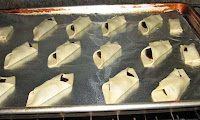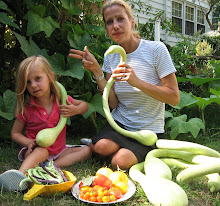It is the kind of dough that mocks you from the dark depths of the fridge as you chill it. “I dare you.”
Well, it did that this year.

Every Christmas, my grandmother used to make what my mom called “The Hungarian Pastry Cookies.” We are not Hungarian. I’m not sure of the origin of this recipe, which at this point consists only of a list of ingredients, one noted direction and a temperature [but no baking time] I scrawled one year on a sheet of reporter’s notebook paper. I did learn this year that when my mother was a child, “Mom-Mom and Nanny [my great great aunt] used to spend a day together, making apricot filling, drinking the apricot brandy, rolling them in powdered sugar over and over again.”
Now, you all know I’m all for a sip or two of brandy anytime, but this is one baking project where a clear head is clearly needed.
I never saw my grandmother make them. I have no instructions, but I’m the only one in the family who knows how to make them. Or is willing to.
So I did again this year.
It is a tender pastry dough, not to be overworked, and quick to turn sticky once your rolling pin hits it. To be honest, though, I’ve never had a problem with it, not even the first year I attempted them. I did this year, though.
As I previously wrote, it was the final batch of dough made that Sunday night after the weekend snowstorm and a few days before Christmas. Perhaps it was the long days and late nights I’d put in, but once the dough came together in my mixing bowl and I went to pre-roll it into 16” x 16” x 1/8” sheets, it stuck to my fingers, it glued itself to the waxed paper, it melted and tore into holes in spots.
Back to the fridge to chill. Then it still didn’t behave. I had to call it a night eventually, but not until I showed the dough who’s boss.
It showed me instead.
All week, I silently checked it as it silently sneered back at me. For the first time, I was not looking forward to Christmas Eve Day, when I make the cookies to be delivered warm out of the oven that night, then still fresh for the extended family on Christmas Day. I could not not make them. That was not an option.
I held my breath that morning, banished all from the kitchen counter and went to work.
 Not “slowly but surely,” but quickly and efficiently. I gave the dough no excuse to gloop up on me. Using a ruler and a pizza wheel (or razor sharp knife), I cut each pre-rolled super-chilled sheet (my secret, shhhh) into sixteen 2” squares. You then put a dollop of filling in, fold over the edges, quickly evacuate them to a cookie sheet, then say a Hail Mary as you slip them into the oven.
Not “slowly but surely,” but quickly and efficiently. I gave the dough no excuse to gloop up on me. Using a ruler and a pizza wheel (or razor sharp knife), I cut each pre-rolled super-chilled sheet (my secret, shhhh) into sixteen 2” squares. You then put a dollop of filling in, fold over the edges, quickly evacuate them to a cookie sheet, then say a Hail Mary as you slip them into the oven.Fillings this year were prune (my favorite), apricot (family favorite & the tradition) and date. In years past, I’ve made a wonderful “stew” of dried figs and star anise. That was absolute blasphemy the first year I did it, as I’d forsaken the walnut filling my grandmother used to make. But everyone ate them then and in subsequent years.
Actually, I observed something this year that I’d seen in the past, but didn’t fully, duly or officially note.
Mom-Mom’s cookies are the first thing every member of my family takes when they arrive. My younger sister, who hosted Christmas this year, puts together quite a spread of appetizers and nibblies no matter what the occasion – pretty much anything and everything any guest could want. But my cousin Craig walked in after a long drive from Pennsylvania and took an apricot cookie – before barely a “Hello.” Ditto for cousin Alicia, even after assaying the table covered with cheeses, dips, crudité, chocolates, etc. My mother’s brother, Vic, makes no false pretenses or apologies: he pours a glass of milk and sits down right next to the cookies for as long a spell as it takes to relive childhood. My father made a beeline for the prune filled cookies. My mom, surprisingly, tried a date-filled cookie first.
“Delicious, good idea Elise,” she said. “But didn’t you make the fig this year?”

















































